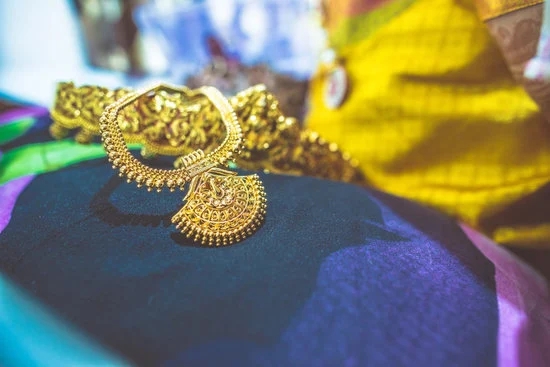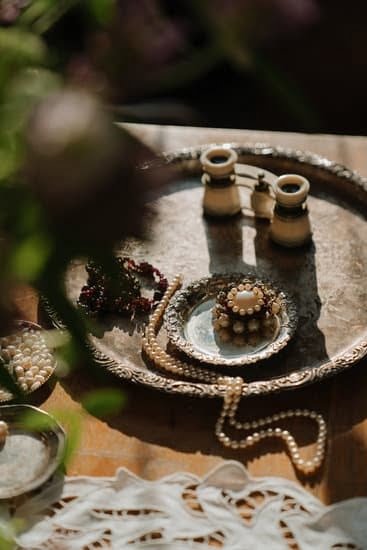The history of chainmail jewelry dates back to ancient times, with its roots deeply embedded in the art of armor making. From medieval knights to modern-day fashionistas, the allure of chainmail jewelry has stood the test of time and continues to captivate jewelry enthusiasts around the world. This article aims to explore the fascinating journey of chainmail jewelry, from its origins as a form of protective armor to its evolution as a sought-after fashion accessory.
Chainmail jewelry is intricately woven together using small metal rings, creating a unique and mesmerizing tapestry that adorns the wearer’s body. The art of chainmail weaving requires precision, skill, and an eye for detail. In this section, we will delve into the techniques and materials used in crafting these exquisite pieces, shedding light on the craftsmanship that goes into each design.
As we embark on this exploration of chainmail jewelry, we will also uncover how this age-old tradition has found its place in modern fashion trends. From runways to red carpets, chainmail jewelry has made a resounding comeback, captivating contemporary audiences with its timeless appeal and undeniable elegance. Join us as we unravel the history, artistry, and symbolism behind chainmail jewelry, delving into its past while also peeking into its future as an ever-evolving form of wearable art.
The Origins of Chainmail Jewelry
Chainmail jewelry has a rich and fascinating history that dates back to medieval times. Originally, chainmail was used as a form of armor to protect soldiers in battle. It was constructed by weaving small metal rings together to create a flexible and protective mesh garment. Over time, however, the functionality of chainmail evolved into an art form and fashion statement.
The history of chainmail jewelry is closely linked to the history of chainmail itself. In ancient times, chainmail was worn for its practical use in combat, providing protection to warriors on the battlefield. As metallurgy advanced, so did the intricacy and beauty of chainmail patterns. This transition from purely functional to ornamental paved the way for the use of chainmail in jewelry.
During the Middle Ages, chainmail retained its status as a symbol of strength and nobility. Knights adorned themselves with elaborate chainmail garments not only for protection but also as a display of wealth and status. This further solidified the connection between chainmail and fashion, as it became a popular choice for royalty and nobility both on and off the battlefield.
| Aspect | Details |
|---|---|
| Functionality in combat | Originally used as armor for soldiers |
| Evolving art form | Transitioned from functional to ornamental over time |
| Symbols of strength and nobility | Worn by knights and royalty as a display of wealth and status |
The Art of Chainmail Weaving
Chainmail weaving is an ancient art form that has been used for centuries to create armor, decorative clothing, and jewelry. The techniques and materials used in chainmail weaving have evolved over time, but the basic principles remain the same. To create chainmail jewelry, artisans use small metal rings that are linked together in intricate patterns to form beautiful and durable pieces.
Techniques for Chainmail Weaving
When it comes to creating chainmail jewelry, there are several popular weaving techniques that artisans use to achieve different patterns and designs. Some of the most common techniques include:
- European 4-in-1 weave: This classic technique involves linking each ring with four others, creating a dense and sturdy pattern.
- Byzantine weave: Characterized by its interwoven and intricate look, this technique involves linking each ring through four others.
- Persian weave: Known for its flexibility and drape, this technique involves using multiple rings to link each ring together.
Materials Used in Chainmail Weaving
In addition to mastering various weaving techniques, artisans also need to carefully select the materials they use for chainmail jewelry. While traditional chainmail was made from iron or steel rings, modern artisans have the option of working with a wide range of materials including:
- Stainless steel: Durable and resistant to rust, stainless steel is a popular choice for chainmail jewelry.
- Copper: Known for its warm reddish color, copper can add a unique touch to chainmail designs.
- Anodized aluminum: Available in a variety of vibrant colors, anodized aluminum is lightweight and versatile.
By mastering these techniques and utilizing different materials, artisans are able to create stunning chainmail jewelry pieces that appeal to both history enthusiasts and fashion-forward individuals. The art of chainmail weaving continues to thrive as more designers experiment with new patterns and materials. As we look towards the future of chainmail jewelry, it’s exciting to imagine what innovative designs and techniques will emerge in the years to come.
The Rise of Chainmail Jewelry in Modern Fashion
Chainmail jewelry has a rich history that dates back to medieval times, where it was primarily used as armor for protection in battle. However, in modern times, chainmail has transitioned from being solely functional to also being an elegant and stylish accessory in the world of fashion. The rise of chainmail jewelry in modern fashion has gained popularity due to its unique and intricate designs that add a touch of edginess and sophistication to any outfit.
In recent years, chainmail jewelry has been embraced by fashion designers and enthusiasts alike, leading to its resurgence in the fashion industry. The use of chainmail in modern jewelry design has opened up a world of creative possibilities, with artisans experimenting with different metals, colors, and weaving techniques to create one-of-a-kind pieces. As a result, chainmail jewelry has evolved from traditional armor-like designs to more delicate and intricate styles that appeal to a broader audience.
Furthermore, the rise of chainmail jewelry in modern fashion can be attributed to its versatility. Whether it’s in the form of statement earrings, layered necklaces, or bold bracelets, chainmail jewelry adds a distinct flair to any ensemble. Its ability to seamlessly transition from day to night makes it a versatile accessory for any occasion.
With an increasing demand for unique and artisanal pieces, the popularity of chainmail jewelry continues to grow in modern fashion. As more designers incorporate this ancient art form into their collections, it’s clear that chainmail jewelry is here to stay as a timeless and captivating addition to contemporary style.
- Transition from functional armor to stylish accessory
- Embraced by fashion designers and enthusiasts
- Versatility in design and appeal across different occasions
Famous Chainmail Jewelry Designs and Designers
Throughout history, chainmail has been used for practical purposes such as armor and protection. However, in modern times, chainmail has found a new purpose as a stylish and unique form of jewelry. Many designers have embraced this ancient technique to create stunning pieces that have captivated the fashion world.
One famous designer known for their chainmail jewelry is Maureen Brusa Zappellini, who has been creating intricate and beautiful pieces for over 30 years. Her work has been featured in galleries and museums around the world, and she is renowned for her meticulous craftsmanship and innovative designs. Another notable designer is Lauren Roberts, whose modern take on chainmail jewelry has gained popularity for its bold and contemporary aesthetic.
Aside from individual designers, there are also luxury fashion brands that incorporate chainmail into their jewelry collections. For example, renowned fashion house Paco Rabanne is known for its use of chainmail in both clothing and accessories, creating edgy and avant-garde pieces that have become iconic in the fashion industry.
| Designer | Notable Works |
|---|---|
| Maureen Brusa Zappellini | Intricate and beautiful pieces with meticulous craftsmanship |
| Lauren Roberts | Modern take on chainmail jewelry with bold and contemporary aesthetic |
| Paco Rabanne | Edgy and avant-garde pieces incorporating chainmail in clothing and accessories |
The history of chainmail jewelry is not only about the techniques and materials used but also about the creative minds behind these exquisite designs that continue to shape the future of this unique art form. These designers have taken an ancient craft and transformed it into wearable art that reflects both tradition and innovation.
The Symbolism and Meaning Behind Chainmail Jewelry
Chainmail jewelry has been around for centuries, and its history is rich and meaningful. The symbolism behind chainmail jewelry is both fascinating and deeply rooted in tradition. From its origins as a form of protection, to its now modern representation as a symbol of strength and connection, chainmail jewelry holds a special significance for many people.
Historical Significance
The history of chainmail jewelry dates back to the medieval era, where it was primarily used as armor for soldiers in battle. The intricate weaving of metal rings served as a form of protection, creating a strong and durable barrier against weapons. Over time, the craftsmanship involved in creating chainmail evolved from just practicality to an art form, with skilled artisans using their expertise to create intricate and beautiful designs.
Symbolism in Modern Times
With the evolution of chainmail from armor to jewelry, its symbolism has also transitioned. In modern times, chainmail jewelry is often seen as a symbol of strength and resilience. The interconnectedness of the metal rings represents unity and bonds, making it a popular choice for those who want to express the idea of being connected or protected. Additionally, the intricate weaving of chainmail can also represent craftsmanship and attention to detail.
Personal Meaning
For many individuals, wearing chainmail jewelry holds personal significance. It can serve as a reminder of inner strength or act as a token of protection. Some may wear it as a symbol of resilience during challenging times, while others may simply appreciate the beauty and artistry of the piece. Regardless of the specific meaning attached to it, chainmail jewelry continues to hold deep significance for many wearers all over the world.
As chainmail jewelry continues to be cherished by people across different cultures and traditions, its symbolism remains timeless and meaningful. Whether worn for fashion or personal significance, this historic craft continues to hold a special place in today’s world.
How to Care for and Maintain Chainmail Jewelry
Chainmail jewelry is a unique and beautiful form of jewelry that requires proper care to maintain its longevity and appearance. With its intricate links and delicate design, chainmail jewelry can easily become tarnished or damaged if not properly cared for. Here are some tips on how to care for and maintain your chainmail jewelry.
Cleaning Chainmail Jewelry
To clean your chainmail jewelry, you can use a simple solution of warm water and mild soap. Gently scrub the jewelry with a soft-bristled brush to remove any dirt or grime. Be sure to rinse the jewelry thoroughly with clean water and pat it dry with a soft cloth. It is important to avoid using harsh chemicals or abrasive materials when cleaning chainmail jewelry, as this can damage the metal.
Storing Chainmail Jewelry
Proper storage is key in maintaining the quality of your chainmail jewelry. When not wearing your chainmail jewelry, it’s important to store it in a cool, dry place away from direct sunlight. Avoid storing multiple pieces of chainmail jewelry together, as this can cause them to tangle or scratch each other. For added protection, consider storing each piece of chainmail jewelry in a separate pouch or compartment to prevent tangles and scratches.
Maintaining Chainmail Jewelry
Regular maintenance is essential for keeping your chainmail jewelry looking its best. Periodically inspect your chainmail jewelry for any signs of damage or wear, such as loose links or tarnishing. If you notice any issues, it’s best to address them promptly by seeking professional repair or cleaning services, if necessary.
By following these simple care and maintenance tips, you can ensure that your chainmail jewelry remains in excellent condition for years to come. Taking good care of your chainmail jewelry will allow you to continue enjoying its timeless beauty and unique craftsmanship.
The Future of Chainmail Jewelry
In conclusion, the history of chainmail jewelry is a fascinating journey from its origins as a form of armor in medieval times to its evolution into a popular fashion accessory in modern times. The art of chainmail weaving has been passed down through generations, and the techniques and materials used have evolved over time. Today, chainmail jewelry has become a symbol of bold and versatile fashion statements, with a rich history behind its intricate designs.
As we look to the future of chainmail jewelry, there are exciting trends and innovations on the horizon. Designers are constantly pushing the boundaries of traditional chainmail weaving techniques, experimenting with new materials, colors, and textures to create innovative and unique pieces. From statement necklaces to delicate bracelets, there is no limit to the creativity that can be expressed through this ancient art form.
Furthermore, as sustainability becomes increasingly important in the fashion industry, there is a growing emphasis on using eco-friendly materials in chainmail jewelry. With more focus on ethical sourcing and environmentally-conscious practices, the future of chainmail jewelry looks promising in contributing to a more sustainable fashion industry.
As we continue to honor the history of chainmail jewelry while embracing new trends and innovations, it is clear that this timeless art form will have a lasting impact on the world of fashion for years to come.
Frequently Asked Questions
What Is the History of Chain Mail Jewelry?
Chain mail jewelry has a rich history dating back to ancient times when it was used for protection in armor. Over time, artisans began to incorporate chain mail into jewelry-making, creating intricate and durable pieces.
Why Did They Wear Chainmail?
People wore chainmail for protection in battle due to its ability to deflect sharp weapons and provide a barrier against attacks. As metallurgy advanced, chainmail became more refined and versatile, leading to its widespread use in various cultures.
What Is the History of Celtic Chainmail?
The history of Celtic chainmail is closely tied to the Celtic culture, known for its intricate designs and craftsmanship. Celtic warriors often wore chainmail as essential armor during battles, showcasing the impressive skill of Celtic blacksmiths in creating functional and beautiful protective gear.

Welcome to my jewelry blog! My name is Sarah and I am the owner of this blog.
I love making jewelry and sharing my creations with others.
So whether you’re someone who loves wearing jewelry yourself or simply enjoys learning about it, be sure to check out my blog for insightful posts on everything related to this exciting topic!





